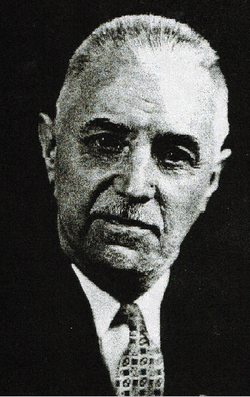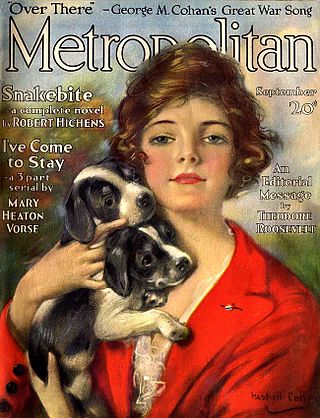Related Research Articles

United Media was a large editorial column and comic strip newspaper syndication service based in the United States, owned by the E. W. Scripps Company, that operated from 1978 to 2011. It syndicated 150 comics and editorial columns worldwide. Its core businesses were the United Feature Syndicate and the Newspaper Enterprise Association.
United Feature Syndicate (UFS) is a large American editorial column and comic strip newspaper syndication service based in the United States and established in 1919. Originally part of E. W. Scripps Company, it was part of United Media from 1978 to 2011, and is now a division of Andrews McMeel Syndication. United Features has syndicated many notable comic strips, including Peanuts, Garfield, Li'l Abner, Dilbert, Nancy, and Marmaduke.

Tribune Content Agency (TCA) is a syndication company owned by Tribune Publishing. TCA had previously been known as the Chicago Tribune Syndicate, the Chicago Tribune New York News Syndicate (CTNYNS), Tribune Company Syndicate, and Tribune Media Services. TCA is headquartered in Chicago, and had offices in various American cities, the United Kingdom, the Netherlands, and Hong Kong.

Ella Cinders is an American syndicated comic strip created by writer Bill Conselman and artist Charles Plumb. Distributed for most of its run by United Feature Syndicate, the daily version was launched June 1, 1925, and a Sunday page followed two years later. It was discontinued on December 2, 1961. Chris Crusty ran above Ella Cinders as a topper strip from July 5, 1931 to July 6, 1941.

Melville Porter Cummin, popularly known as Mel Cummin, was a magazine illustrator and a newspaper staff artist; a notable cartoonist in the early decades of American comic strips; and a Golden Age comic book artist and art director. He was active in the Society of Friends. Cummin was also a well-known naturalist and explorer.
Good Time Guy is a humorous syndicated comic strip that was distributed by Metropolitan Newspaper Service from June 27, 1927 to December 6, 1930.
A comic strip syndicate functions as an agent for cartoonists and comic strip creators, placing the cartoons and strips in as many newspapers as possible on behalf of the artist. A syndicate can annually receive thousands of submissions, from which only two or three might be selected for representation. In some cases, the work will be owned by the syndicate as opposed to the creator. The Guinness World Record for the world's most syndicated strip belongs to Jim Davis' Garfield, which at that point (2002) appeared in 2,570 newspapers, with 263 million readers worldwide.

Tarzan, a fictional character created by Edgar Rice Burroughs, first appeared in the 1912 novel Tarzan of the Apes, and then in 23 sequels. The character proved immensely popular and quickly made the jump to other media, including comics.

William Marien Conselman was an American screenwriter who also wrote newspaper comic strips under his Bill Conselman byline and sometimes under the pseudonym Frank Smiley.

Metropolitan was an American magazine, published monthly from 1895 to 1925 in New York City. Former U.S. President Theodore Roosevelt was editor of the magazine during World War I when it focused on politics and literature. It was sometimes named, or called, Metropolitan Magazine or The Metropolitan, and its final issues were published as Macfadden's Fiction-Lover's Magazine.

McClure Newspaper Syndicate, the first American newspaper syndicate, introduced many American and British writers to the masses. Launched in 1884 by publisher Samuel S. McClure, it was the first successful company of its kind. It turned the marketing of comic strips, columns, book serials and other editorial matter into a large industry, and a century later, 300 syndicates were distributing 10,000 features with combined sales of $100 million a year.
The Bell Syndicate, launched in 1916 by editor-publisher John Neville Wheeler, was an American syndicate that distributed columns, fiction, feature articles and comic strips to newspapers for decades. It was located in New York City at 247 West 43rd Street and later at 229 West 43rd Street. It also reprinted comic strips in book form.
The Central Press Association was American newspaper syndication company based in Cleveland, Ohio. It was in business from 1910 to 1971. Originally independent, it was a subsidiary of King Features Syndicate from 1930 onwards. At its peak, the Central Press supplied features, columns, comic strips, and photographs to more than 400 newspapers and 12 million daily readers. Notable comic strips that originated with Central Press include Brick Bradford, Etta Kett, and Muggs McGinnis.

Charles Plumb was an American cartoonist best known for maintaining a high quality of artwork on the comic strip Ella Cinders over three decades. He usually signed his work with the signature Charlie Plumb or Chas. Plumb. He also drew the topper strip Chris Crusty which ran above Ella Cinders from 1931 to 1940.
The Register and Tribune Syndicate was a syndication service based in Des Moines, Iowa, that operated from 1922 to 1986, when it was acquired by King Features to become the Cowles Syndicate affiliate. At its peak, the Register and Tribune Syndicate offered newspapers some 60 to 75 features, including editorial cartoonist Herblock, comic strips, and commentaries by David Horowitz, Stanley Karnow, and others.
The Public Ledger Syndicate was a syndication company operated by the Philadelphia Public Ledger that was in business from 1915 to circa 1950. The Ledger Syndicate distributed comic strips, panels, and columns to the United States and the United Kingdom, Ireland, Canada, Sweden, New Zealand, and Australia. The syndicate also distributed material from the Curtis Publishing Company's other publications, including The Saturday Evening Post, Ladies' Home Journal, and The Country Gentleman.
The New York Herald Tribune Syndicate was the syndication service of the New York Herald Tribune. Syndicating comic strips and newspaper columns, it operated from c. 1914 to 1966. The syndicate's most notable strips were Mr. and Mrs., Our Bill, Penny, Miss Peach, and B.C. Syndicated columns included Walter Lippmann's Today and Tomorrow, Weare Holbrook's Soundings, George Fielding Eliot's military affairs column, and John Crosby's radio and television column. Irita Bradford Van Doren was book review editor for a time.
Associated Newspapers, Inc. was a print syndication service of columns and comic strips that was in operation from 1912 to c. 1966. The syndicate was originally a cooperative of four newspapers: The New York Globe, the Chicago Daily News, The Boston Globe, and the Philadelphia Bulletin. Associated Newspapers was led by Henry Herbert McClure (1874-1938), a cousin of S. S. McClure, founder of the McClure Syndicate, the first American newspaper syndicate. In 1930, Associated Newspapers was acquired by and became a subsidiary of the Bell Syndicate. The syndicate's most successful, long-running strip was Gladys Parker's Mopsy.
The New York World was one of the first newspapers to publish comic strips, starting around 1890, and contributed greatly to the development of the American comic strip. Notable strips that originated with the World included Richard F. Outcault's Hogan's Alley, Rudolph Dirks' The Captain and the Kids, Denys Wortman's Everyday Movies, Fritzi Ritz, Gus Mager's Hawkshaw the Detective, Victor Forsythe's Joe Jinks, and Robert Moore Brinkerhoff's Little Mary Mixup.
References
- 1 2 Cornell Alumni News, XII (4), 20 October 1909.
- 1 2 3 "United Feature Syndicate Buys Metropolitan Service From Elser: Both Firms Will Retain Separate Identities, With Elser Remaining as Vice-President — Monte Bourjaily to Direct Both Organizations," Editor & Publisher (March 15, 1930). Archived at "News of Yore 1930: Another Syndicate Gobbled," Stripper's Guide (May 4, 2010).
- ↑ Hudson, Frederic, Alfred McClung Lee, and Frank Luther Mott. American Journalism 1690-1940, Volume 4 (Psychology Press, 2000), p. 591.
- ↑ "Feature Services Merged: Bell Syndicate Takes Over Metropolitan Newspaper Service," Editor & Publisher (April 3, 1920).
- ↑ Booker, M. Keith. "United Feature Syndicate," in Comics through Time: A History of Icons, Idols, and Ideas (ABC-CLIO, 2014), p. 399.
- ↑ Holtz, Allan. "Robert L. Dickey and his Dogs," Stripper's Guide (November 3, 2005).
- ↑ Metropolitan Newspaper Service, & Conselman, W. (1927). "Good Time Guy, a new sunrise in the comic world" by William M. Conselman, author of Ella Cinders , writing under the nom de plume of Frank Smiley with drawings by Mel Cummin. New York: Metropolitan Newspaper Service.
- ↑ Markstein, Don. "Tarzan of the Apes". Don Markstein's Toonopedia. Archived from the original on November 23, 2014. Retrieved October 7, 2012.